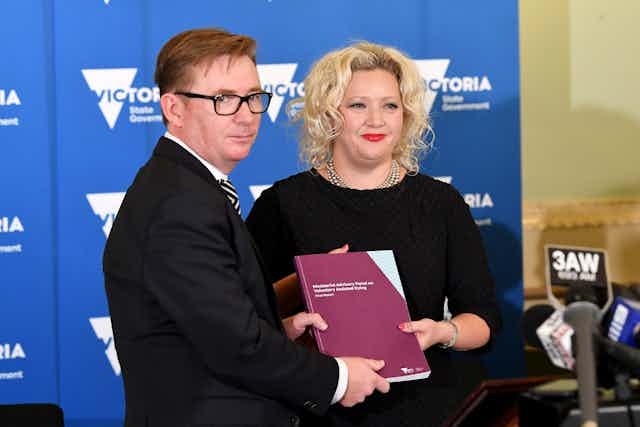An independent group of experts set up by the Victorian government has today delivered its final report outlining 66 recommendations for how voluntary assisted dying would work in the state.
Chaired by former head of the Australian Medical Association, Brian Owler, the Ministerial Advisory Panel’s role was to work out how legislation should be drafted to allow terminally ill people to receive assistance to die. The panel based its report on the recommendations of the Parliamentary committee’s Inquiry into end of life choices in December 2016.
Legislation giving effect to the report is likely to be tabled in the Victorian Parliament within a month.
Who does the law cover?
At the heart of debates about assisted dying are eligibility criteria – who can get assistance to die and who cannot. The panel’s recommendations are broadly consistent with the report of the parliamentary committee. Access is allowed for an adult who can make their own decisions, is terminally ill and their suffering cannot be relieved. They must also be a resident of Victoria.
But the panel widens the committee’s earlier recommendation that a person must be “at the end of life (final weeks or months of life)” to be granted their request. Instead, the current report states the “incurable disease, illness or medical condition” must be expected to cause death in no later than 12 months.
While we agree eligibility should be based on a terminal illness, we don’t favour time limits as they are arbitrary and difficult to accurately predict. They can also lead to people taking harmful steps to fall inside them, such as starving themselves.
But the panel’s recommendation to extend the time to 12 months is still a better approach than the committee’s, as it is likely forming a clinical view about prognosis will be more manageable in that time. Providing a set time frame also avoids the uncertainty of the vague use of the phrase “at the end of life”.
Also of note is that the panel specifically stated mental illness alone and disability alone will not satisfy eligibility requirements; but nor will they exclude access to voluntary assisted dying.
What assistance can be provided?
This is primarily a physician-assisted dying model, which means the patient is expected to take the lethal dose of medication themselves. This is a narrow approach to assisted dying as it is the person themselves who takes the final step to end life, not the doctor.
The panel’s approach is consistent with the committee’s report – both are broadly along the lines of the US assisted dying model such as the one in Oregon.
There are downsides to this and we favour a more inclusive model (like in Canada or under the European model) that permits assistance to die being directly provided by a doctor as well. This choice better reflects the autonomy that underpins these laws.
But the panel (and the committee) did recommend an exception where the person is physically unable to take the medication or digest it themselves. This may not be used often but helps address potential discrimination, for example on the grounds of physical disability which prevents someone taking the medication themselves.
What safeguards are there?
The panel has proposed a very rigorous process - comprised of 68 safeguards – that involves three separate requests for voluntary assisted dying (one which is witnessed by two independent witnesses) and two independent medical assessments.
A patient seeking assistance to die must be provided with a range of information including about diagnosis and prognosis, treatment options available, palliative care, and the expected outcome and risks of taking the lethal dose of medication. Doctors involved will have to receive special training about the law and how it operates.
Other safeguards are at the systems level, with a Voluntary Assisted Dying Review Board recommended to examine each case and also to report on how the scheme as a whole is operating. The panel has also proposed a range of new offences specifically about voluntary assisted dying to deter conduct outside the scope of the regime, such as an offence against inducing someone to request assisted dying.
Will these recommendations become law?
Strong public opinion, shifting views in the health and medical professions and international trends towards allowing assisted dying mean it will become lawful in Australia at some point. But will it be in Victoria, and soon?
The politics of assisted dying are notoriously fickle and this is the latest of over 50 bills in Australian parliaments addressing this issue over the past two decades.
But as we have argued in the past, features of this law reform effort suggest it could happen. The process of examining the issue has been very careful, inclusive and thoughtful with multiple reports and engagement with expert opinion and national and international evidence.
This is a narrow assisted dying model with a lot of safeguards. There is also high level and public support of senior politicians on both sides of politics. But as always, the ultimate test is what happens on the floor of parliament.

